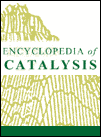Nitrile Hydratase
Abstract
Nitrile hydratases (NHases) are metalloenzymes, found in soil bacteria, first isolated from toxic wate sites, which catalyze the hydration of nitrile to amides. These contain either a mononuclear non-heme Fe3+ or a non-corrinoid Co3+. Initial spectroscopic studies demonstrated that both the metal centers are low spin (S = 1/2 for Fe3+ and S = 0 Co3+). Two crystal structures of Fe-NHase from Rhodococcus R312 have shown that the iron center is ligated by three cysteinates in a fac configuration, two amide nitrogens from the peptide backbone, and a hydroxide (active form) or NO (inactive form) in a site trans to a cysteinate. The electronic spectrum of the active form of Fe-NHase is dominated by an intense π-sulfur-to-metal charge transfer band near 700 nm. The EPR and electronic absorption spectra of Fe-NHase are both substrate- and pH-dependent. NHase has been used industrially in the multi-kiloton production of commodity amides, has been utilized to a limited extent as a reagent for organic synthesis, and may find use in the field of chemical waste treatment. Model compounds, in combination with biochemical and biophysical techniques, have proven useful in answering fundamental questions concerning NHase, but several key issues remain unresolved. For examle, the mechanism of NHase catalysis remains to be elucidated, and the involvement of low spin, rather than the more reactive high spin metal ions (Co3+, Fe3+) in these reactions has yet to be explained.



